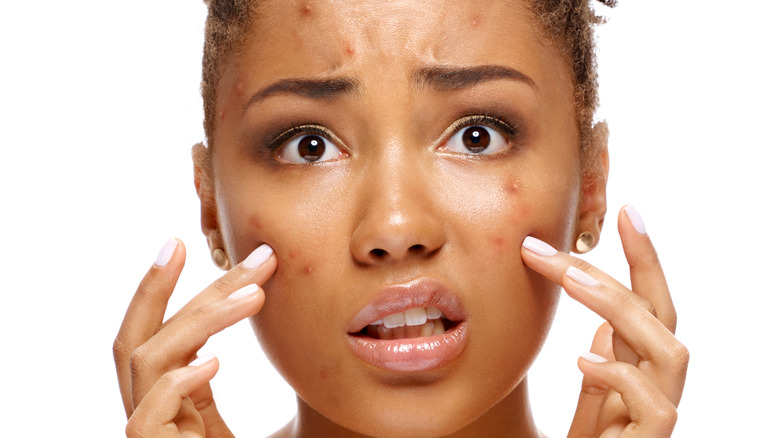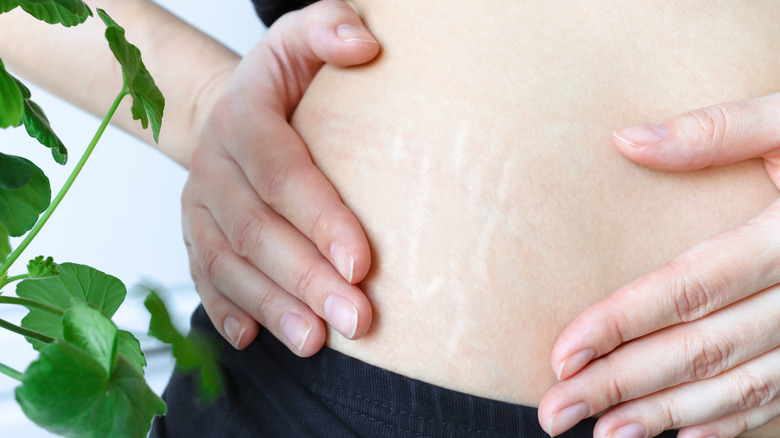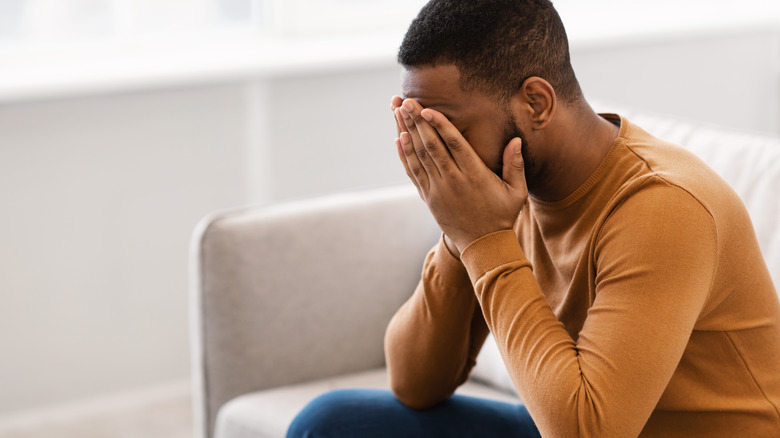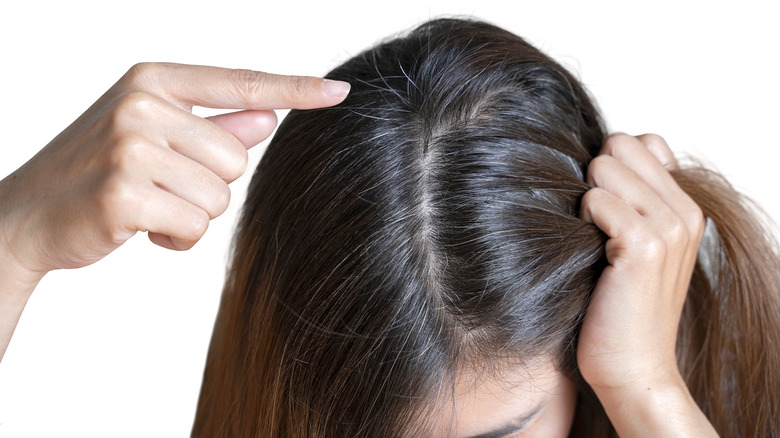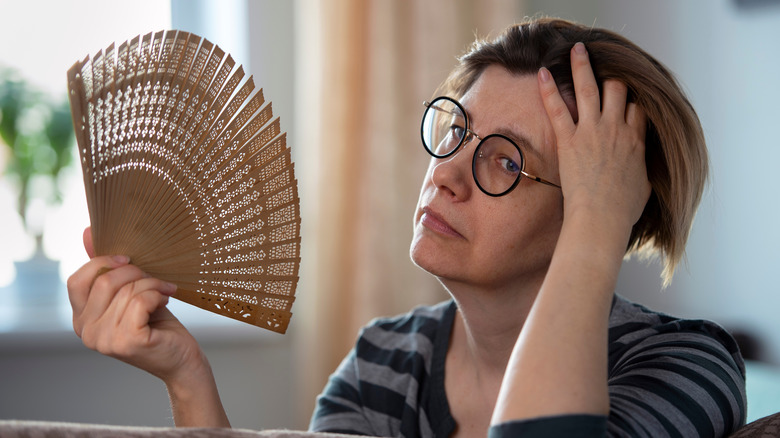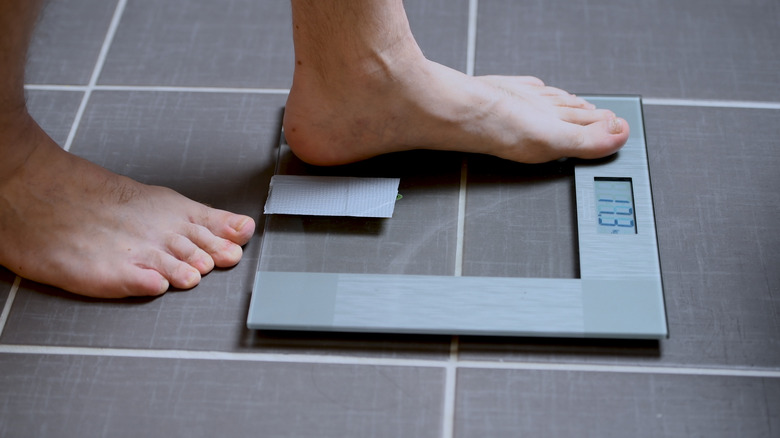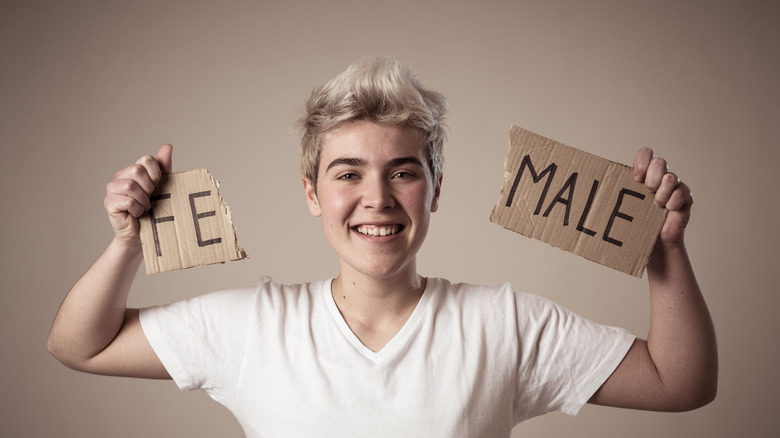Is Second Puberty Real?
As if the first one wasn't bad enough, there's word going around that there's a second puberty. Is this true, you may ask, with fear in your eyes and a knot in your stomach. Relax. Not really. The phrase "second puberty" is not a medical term, and there are no scientific studies to prove it exists (via Healthline).
However (you knew that was coming), the body does naturally change as it ages over the course of decades. These changes occur in a person's 20s, 30s, and 40s, and are part of the natural aging process. There are certain second puberty changes that both men and women go through (we're looking at you, loss of muscle mass), but there are others that are specific to one gender. And then there are the ones that occur in transgender adults undergoing hormone replacement therapy –- changes that may be the complete opposite of those that happened during their first puberty (per WebMD).
Keep in mind that a second puberty will differ significantly from the original one. Neither men nor women will experience a growth spurt in height (sorry!). Men won't have voices that suddenly start cracking. And women won't develop any more breasts –- or even bigger ones (sorry again). Although it might differ from the first puberty, a second puberty -– maybe even a third or fourth one! — is on your body's agenda during the coming decades.
What second puberty is like for women in their 20s
Luckily, puberty part deux in the 20s is not nearly as fraught as the first go-round. There are actually some things most women will appreciate happening, in addition to the things they'd rather avoid. For instance, a woman reaches both peak muscle strength and bone mass in this decade, per Flo. The increase in bone mass is the body's way of banking it for menopause when bone begins to break down, as Maria Sophocles, M.D., told Cosmopolitan. Also noteworthy: Periods will settle down and finally adapt to a regular rhythm. This is because women at this age are at the pinnacle of fertility, and nature is making it easier to conceive.
The downside to this decade, which makes it a bona fide second puberty, are the hormonal and metabolic changes. These normal shifts will cause a slow and creeping weight gain, with fat likely settling in places like the hips, thighs, and breasts. For some women, this may be a welcome development, as the fat deposits may create curves. With those curves, however, may come stretch marks (via Flo). And the rest of the skin may undergo changes too. Acne may be worse than usual, due to hormones and the use of certain types of birth control, as Gwendolyn Quinn, Professor in the Department of Population Health, New York University School of Medicine, writes for Flo.
Emotionally, many 20-something women are dealing with their personal and social lives for the first time as independent adults, and they may experience significant psychological challenges, which can lead to symptoms of anxiety or depression. This is a natural adjustment period as women keep pace with shifting priorities and responsibilities.
What second puberty is like for men in their 20s
For men as well as women, bone and muscle mass reach their peak during the 20s. But in men, this is thanks to the huge production of testosterone between the ages of 18 and 25 as Walter Thompson, a professor of kinesiology, health, and nutrition at Georgia State University, told Men's Health. Because muscle tissue burns more calories than fat (via the Mayo Clinic), it's relatively easy for men to maintain a consistent weight in their early 20s (i.e., during college, what with playing sports regularly, running all over campus to get to class, or generally not sitting in one place too long). But once the mid-20s hit and that level of physical activity is traded in for a sedentary office job, the pounds sneak on — especially for those who don't give up the late-night cookie deliveries or who continue to inhale a whole pizza in a sitting. "From the day of graduation, most men start gaining weight," says Dr. Thompson to Men's Health. "Before long, you're sitting at your desk and you're 25 pounds overweight."
Then there are the emotional changes. You've likely heard of the mid-life crisis, but there is a quarter-life crisis as well in the late 20s, per the Harvard Business Review. It has several stages: When an adult enters into a commitment — whether to a person, a job, or a place to live — he may feel trapped. On breaking that commitment, emotions shift to loneliness, prompting a period of reflection on goals and priorities. Following this reflective time, though, is a period of greater clarity, characterized by the pursuit of new and fulfilling interests and goals. So although it can hurt, this crisis seems to help bring about a more meaningful and happier life.
What second puberty is like for women in their 30s
Alas, bone and muscle mass gradually begin to decline for women in their 30s, changing the shape of their bodies. They start to lose lean (muscle) tissue, while the amount of body fat increases at a regular pace after 30, according to MedlinePlus. In addition, as metabolism decreases by 2-4% each decade, 30-something women tend to put on more weight than they did previously (via Cosmopolitan). Skin and hair also show signs of aging, from noticeable wrinkles to the first glints of gray (per Flo). For better or worse, a woman's chances of getting pregnant are not as good as they were in the fertile 20s.
Thirty-something women may also experience times of extreme stress due to the many responsibilities of adult life (via Bustle), as well as anxiety about major decisions –- regarding marriage, a career, or children –- that will affect them for the rest of their lives.
Even the brain begins aging in this decade. After the age of 30, it loses about 50,000 neurons a day (per Health) and certain areas of the brain shrink, including those that are vital for memory, planning, and a host of complex mental activities. Luckily, there are still lots left for the decades ahead, as the average brain has more than 100 billion neurons — and even with the loss of some, it learns to adapt.
What second puberty is like for men in their 30s
It's the dreaded drop, drop, drop of testosterone. Levels begin to decrease about 1% a year starting after age 30, per the Cleveland Clinic. This is entirely normal and won't typically be noticeable in your 30s. However, there are other changes related to aging that will be. For instance, flexibility and stamina will begin to decline in this decade. Most men this age aren't as active as they had been in the past, and this affects both muscles and aerobic capacity. "There's actually a shortening of both muscle and connective tissue," Brent Feland, an aging and flexibility researcher at Brigham Young University, said to Men's Health. As for stamina, its decline in the mid-30s can be traced to the fact that the body's ability to pull oxygen from the blood lessens, bringing less fuel to power the heart and muscles.
There are a medley of physical changes: A man's body shape morphs and his strength declines as his muscle mass drops and metabolism slows. The body now needs 12 fewer calories each day for every year after age 30 as Jordan Metzl, M.D., author of "The Young Athlete: A Sports Doctor's Complete Guide for Parents," told Men's Health. And, as in women, body fat increases in men steadily after age 30, according to MedlinePlus.
What second puberty is like for women in their 40s
In women, lots of major physical and emotional changes begin in this decade and continue into the 50s. For one thing, they begin losing height — people typically lose a half inch every decade after age 40, leading to a total of 1 to 3 inches over the rest of their lifetime (per MedlinePlus). This is due to shrinking discs in the spine (via Healthline), as well as natural changes in the bones, joints, and muscles.
There's one surprising change that happens inside her body that a woman won't notice: Between the ages of 25 and 30, her pelvis reaches its full width, to allow for the birth of a child. But at about the age of 40, the pelvis actually begins to narrow due to a drop in estrogen during perimenopause, says a study out of Switzerland. Researchers believe that a narrower pelvis is more stable and better able to withstand the forces generated by walking. A woman's previous curves may not be as apparent as they once were.
But by far the most salient sign of a second puberty in the 40s is that women this age experience perimenopause and then, eventually, menopause. Perimenopause, which is the transition to menopause, generally begins in the 40s (per WebMD). During perimenopause, estrogen levels drop and lead to such challenges as irregular periods, vaginal dryness, fatigue, and hot flashes. Emotional symptoms may include irritability, mood swings, and lower sex drive. Menopause itself occurs at an average age of 51.
What second puberty is like for men in their 40s
In men in their 40s, the decrease of testosterone that began in their 30s now becomes apparent. This period is called male menopause or andropause (per Healthline). One obvious sign of andropause is difficulty maintaining erections, but there are many other symptoms ranging from insomnia to development of breasts to reduced sex drive. Men may also find it difficult to urinate due to a growth spurt of the prostate. Psychologically, a man in andropause may experience depression, decreased motivation, and difficulty concentrating (via Healthline).
As with women in their 40s, men begin to lose height at this age and the body begins adding fat to –- and subtracting muscle from -– its overall composition. Typically the pounds will accumulate on the chest and belly (via Everyday Health). A man will usually gain weight up until the age of 55 (per MedlinePlus), then will begin to shed pounds, possibly due to the natural drop in testosterone that accompanies aging. With lower levels of this hormone, muscle tissue is replaced by fat, which weighs less than muscle.
Second puberty may happen in transgender people
All of the above information is for cisgender people. Transgender folks may indeed experience a second puberty if they decide to undergo gender-affirming treatment after the initial puberty. The hormones given may cause them to experience puberty symptoms associated with their affirmed gender.
Transgender women undergoing hormone therapy experience breast development, softer skin, sparser body hair, fat stores in the hips, thighs, and butt, and mood changes. Transgender men will notice that their bodies take on a more masculine appearance, with muscle growth and a change in body shape. Skin will become oilier, facial hair will increase, while hair on the head may be lost. The voice will change, the clitoris will enlarge, and periods will stop.
Overall, physical changes due to hormone therapy can take anywhere from one month to five years to reach maximum effect (per WebMD). The puberty of cisgender people generally develops over five years (per Cleveland Clinic). However, the emotional changes brought on by hormone therapy may happen within weeks by quickly easing the feelings of gender dysphoria. In natural puberty — ask any parent of an adolescent — emotions seem to be on a roller coaster for years on end.
How to combat the problems that come with second puberty
Starting as soon as possible — yes, in your 20s — is the best way to prevent the negative aspects of second puberty. With that said, it's never too late to start. Among the recommendations for both men and women are two classics: Get regular exercise and eat a healthy diet (via Men's Health). Exercise includes both activity to maintain aerobic capacity and workouts that build muscle. Interval training is a good bet for aerobics, while yoga is an excellent way to work on muscles, balance, and flexibility, with its full range of motions and holding positions. Stretching is of paramount importance. In any activity, you'll want to focus on your form — beginning in your 30s, tendons and joints will lose strength, making them more prone to injuries.
With age, your metabolism will decrease, and you'll need to slow your caloric intake to match its pace. Avoid "cleaning the plate" and snacking from the container. Keep fruits and veggies visible in your fridge, and hide the not-so-healthy foods in the vegetable drawer, suggests Nancy Clark, senior sports nutritionist at Boston-based Healthworks Fitness Center, to Men's Health. To support skin health, be sure to drink lots of water to keep your skin elastic (per Flo). Retinoid creams and emollients can also help treat a variety of skin conditions.
Finally, see your doctor annually, particularly to check vital lipoprotein (i.e., "bad cholesterol") levels (via The Healthy). If it's high, you and your doctor will figure out what needs to be done to prevent health problems in the future.

